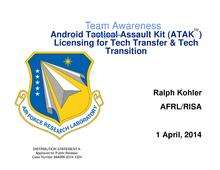Android Tactical Assault Kit
The Android Tactical Assault Kit (ATAK) is an Android smartphone geo-spatial infrastructure app built using NASA World Wind. This "Government Open Source” project from the Air Force Research Lab in Rome, NY when combined with a network or radios, enables sharing/presentation of voice, text chat, video, pictures, and an interactive, layered, shared, moving map... plus many other niche data types for the tactical user. The app's human interface intent is to provide warfighters "up-to-the second understanding of what’s going on around them."[1]
Initially created in 2010,[2][3] and based on the NASA WorldWind Mobile codebase its development and deployment has grown slowly.[4] It is also known as the "Android Team Awareness Kit" and incorrectly reported as the "Android Terminal Assault Kit."[5][6][7]
While ATAK has been fielded, it also remains an active research program at AFRL.
.jpg)
Civilian & Military capabilities (available in the public/licensed version) include:
- Online and offline mapping (most standard formats), with a fast rendering engine
- Web Browser, JavaScript, API
- Collaborative mapping, including points, drawings, locations of interest, kml, maps
- Location marking, sharing, history,
- Chat, file sharing, photo sharing, video sharing, streaming
- Navigation (walking/hiking, driving, also useful for some flying)
- Altitude profiling between locations, routes w/ DTED, SRTM
- Cell phone, WiFi, civilian radio controls, interface
- Skydiving tool (w/winds for better prediction)
- Hunting, Fishing, Ornithology, Wildlife Site Survey
Military unique capabilities (for US military users only) include:
- Site Survey Tool
- Targeting
- Mensuration (precise geo-location)
- Runway Survey Tools
- Military radio controls, messages, interface
Plugin Architecture
ATAK has a plugin architecture which allows developers to add functionality to ATAK.
Polaris integrated its Ground Guidance software into an ATAK Plugin to allow on and off-road routing for mounted and dismounted soldiers, accounting for terrain, weather, enemy activity and equipment load.[8]
Connections to other programs
ATAK began in August, 2010 and was originally based on NASA's WorldWind Mobile. The goal was to demonstrate robust information sharing in a mobile format. Oct 14, 2014 U.S. Army Geospatial Center recommended AFRL's Android Tactical Assault Kit (ATAK), over the world-leader Esri's Commercial Joint Mapping Tool Kit (CJMTK), NASA's World Wind, and the Army's Globe Engine (AGE) for map engine driving the Nett Warrior End User Device. ATAK was selected due to similar capabilities with CJMTK, similar risk, and less than one-third the total cost. Read the full, public released report Nett Warrior Map Engine Trade Study.
In September, 2015, DARPA reported that ATAK was used in a successful demonstration of the Persistent Close Air Support Program, and is in use by thousands of users.
According to a January, 2016 article in National Defense Magazine, "[ATAK] has already been fielded to AFSOC units".
On July 15, 2016 a news article by DoDBuzz published an article stating "The iTAC (sic) will replace the Android Tactical Assault Kit". (abbreviated elsewhere in the article as ATAC). No source was given for this assertion.
Because of ATAK's excellent suitability to coordinating people over Geography, ATAK is made available to Federal Government users and their contractors who need such coordination. ATAK is also made available to Government researchers who wish to experiment with geospatial collaboration without building their own systems.
Other Versions
In addition to the Android Version, there is also a Windows version (WinTak) and an iPhone version under development (iTak).
Commercial Licensing
In January, 2015, AFRL began licensing ATAK through TechLink to U. S. companies, for commercial use to support state/local government uses as well as civilian uses. As of November 2015, twenty five companies have licensed ATAK for commercial uses (TechLink Licensing site).
For More Information:
- See the briefing (click on image right)
- ATAK YouTube Channel with many how-to videos
- Black Diamond Apex System running ATAK

References
- ↑ http://romesentinel.com/news?newsid=20131029-142154
- ↑ "Archived copy" (PDF). Archived from the original (PDF) on 2014-05-20. Retrieved 2014-05-20.
- ↑ https://www.cs.drexel.edu/~kfu22/me/docs/FP-MILCOM-Paper.pdf
- ↑ https://www.fbo.gov/index?s=opportunity&mode=form&tab=core&id=8f69fc9a1ac486675a2d08a5ac57cc41
- ↑ http://www.theepochtimes.com/n3/320781-android-terminal-assault-kit-us-forces-could-use-app-to-call-in-airstrikes/
- ↑ http://www.militarytimes.com/article/20131016/NEWS04/310160005/App-could-allow-troops-call-airstrikes
- ↑ "Archived copy". Archived from the original on 2014-05-20. Retrieved 2014-05-20.
- ↑ http://soldiersystems.net/2015/11/12/juggernaut-board-mff-t2/
External Links
- Official ATAK Map website
- ATAK milBook Group
- DARP PCAS Press Release
- DoDBuzz article " 'Army SOF to Trade in Its Androids for iPhones'
- Persons holding a United States Official email address (e.g. .gov or .mil) may register to download a copy of the official versions of ATAK and WinTak at ATAKmap.com